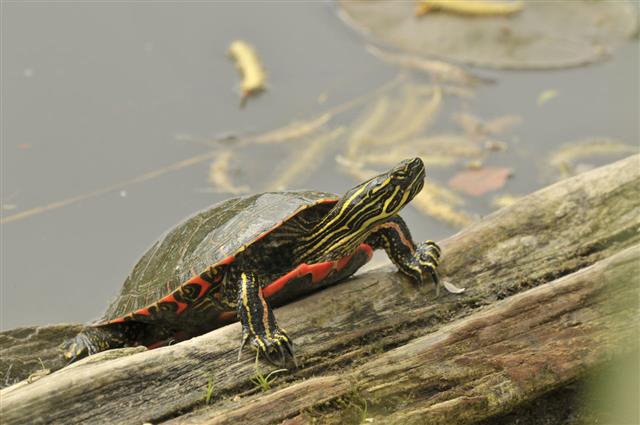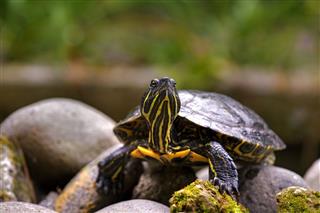
Painted turtles are beautiful and attractive, thanks to their bright color patterns. Here are some painted turtle facts which will help you learn more about these reptiles…
Name Game!
Painted turtles range from a dark shade of olive green to black. They get their name from the red, orange, and yellow stripes on their neck, head, and tail.
Painted turtles have been walking this earth for more than 15 million years. A painted turtle basking in the sun’s warmth is an indication that spring is almost around the corner. These turtles are commonly found in the continent, and are spotted towards the end of winter. Their scientific name is Chrysemys picta, and there are four types of painted turtles, found in various locations and habitats.
Classification of Painted Turtle
Kingdom: Animalia
Phylum: Chordata
Class: Reptilia
Order: Testudines
Family: Emydidae
Genus: Chrysemys
Species: Chrysemys picta
Painted Turtles Distribution

Southern Painted Turtles (Chrysemys picta dorsalis)
Found in southern Illinois and parts of Mississippi
Eastern Painted Turtles (Chrysemys picta picta)
Found in southeastern parts of Canada
Midland Painted Turtles (Chrysemys picta marginata)
Found in southern parts of Ontario and Quebec
Western Painted Turtles (Chrysemys picta bellii)
Found in Ontario and British Columbia
Painted Turtle Habitat
The decorative patterns and colors of the painted turtle have fascinated everyone so much, that today the turtle is one of the best-studied turtles in the world. Painted turtles are also very popular as pets, but before you get one, it’s better to keep certain facts in mind, so that it becomes easier for you to know the needs of your pet.
Appearance
The average size of painted turtles are between 4 and 10 inches.
The average size of painted turtles are between 4 and 10 inches.
The shell of the painted turtle is smooth and oval in shape and has a flat bottom. The color of the carapace (top part of the shell) may vary from dark olive to black. The color of the plastron (bottom part of the shell) is usually yellow, but sometimes can also be bright red with yellow markings in the center.
Males painted turtles can be differentiated from females by their smaller size, longer tail, and front claws with thick, long nails.
If you look carefully behind the eyes of the painted turtle, you will notice a yellow streak with a yellow spot right behind it.
Habitat and Diet
The best home for painted turtles are freshwater bodies with soft bottoms and a place to bask in the sun near the water body. They are found in still or slow-moving water bodies like ponds, streams, creeks, or rivers with muddy bottoms. Water bodies with fast-moving currents are not suitable for these reptiles.
Painted turtles are omnivorous and mainly feed on plants and small animals such as fish, crustaceans, and aquatic insects.
Painted turtles do not have teeth, instead they have sharp and horny ridges on their upper and lower jaw, which help them chew or bite. They have their food in the water because on land they cannot move their tongue freely, making handling of food difficult.
Behavior
Painted turtles bask in the sun for long hours to get rid of parasitic leeches, and to produce vitamins. They are diurnal; at night they sleep at the bottom of the pond.
During winters, painted turtles hibernate by burrowing deep into the mud at the bottom of the pond. They can live for months without oxygen during this phase. On the onset of spring they become active again.
The hearing sense of painted turtles is poor, however, their sense of smell is well-developed. They communicate with each other through touch, and a male initiates courtship by stroking the female’s cheeks with their front claws.
Life Cycle
The mating season of painted turtle is from April to July, and mating takes place at the bottom of ponds or lakes. The female searches for a nesting place, and lays between 4 to 20 eggs.
The incubation period is about 70 to 90 days. The hatchlings survive on the yolk of the egg for a week after hatching. Female turtles grow rapidly and attain sexual maturity between the age of 6 and 10 years.
The growth of male painted turtles is slower than females, however, they attain sexual maturity earlier, between the age of 2 and 4 years.
The lifespan of a painted turtle varies; they are generally known to live between 20 and 40 years.
Painted Turtles as Pets
According to Federal law, keeping turtles as pets is prohibited. Check related laws and obtain permit papers accordingly if you wish to keep painted turtles as pets. According to the IUCN, painted turtles are listed in the ‘Least Concern’ category.
Proper housing and shelter must be provided for painted turtles as pets. The minimum size of the water tank should be 30 gallons with a basking site in it. Regular change and filtration of water in the tank is necessary. The temperature of the tank should be maintained between 75° F and 86° F.
Painted turtles can carry salmonella, a contagious bacterial disease that affects the human intestines. Hence, maintaining cleanliness and hygiene after handling a turtle is important.
A painted turtle thrives better in its natural habitat. Instead of keeping turtles as pets, their adoption is encouraged. However, if you do wish to keep these turtles as pets, a long commitment and seriousness is extremely necessary. Make sure that you know all about painted turtle care and handling beforehand, so that you can take excellent care of them.























